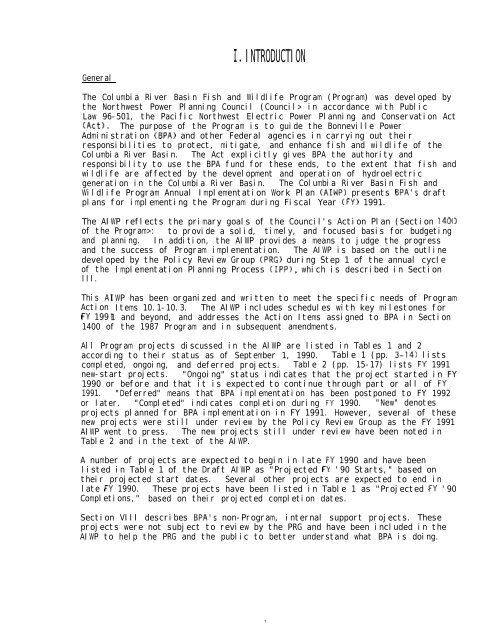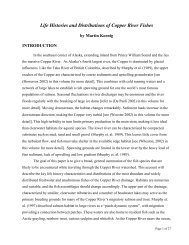columbia river basin fish and wildlife program annual ...
columbia river basin fish and wildlife program annual ...
columbia river basin fish and wildlife program annual ...
Create successful ePaper yourself
Turn your PDF publications into a flip-book with our unique Google optimized e-Paper software.
General1, INTRODUCTIONThe Columbia River Basin Fish <strong>and</strong> Wildlife Program (Program) was developed bythe Northwest Power Planning Council (Council> in accordance with PublicLaw 96-501, the Pacific Northwest Electric Power Planning <strong>and</strong> Conservation Act(Act>. The purpose of the Program is to guide the Bonneville PowerAdministration (BPA> <strong>and</strong> other Federal agencies in carrying out theirresponsibilities to protect, mitigate, <strong>and</strong> enhance <strong>fish</strong> <strong>and</strong> <strong>wildlife</strong> of theColumbia River Basin. The Act explicitly gives BPA the authority <strong>and</strong>responsibility to use the BPA fund for these ends, to the extent that <strong>fish</strong> <strong>and</strong><strong>wildlife</strong> are affected by the development <strong>and</strong> operation of hydroelectricgeneration in the Columbia River Basin. The Columbia River Basin Fish <strong>and</strong>Wildlife Program Annual Implementation Work Plan (AIWP) presents BPA's draftplans for implementing the Program during Fiscal Year (FY) 1991.The AIWP reflects the primary goals of the Council's Action Plan (Section 140(of the Program>: to provide a solid, timely, <strong>and</strong> focused basis for budgeting<strong>and</strong> planning. In addition, the AIWP provides a means to judge the progress<strong>and</strong> the success of Program implementation. The AIWP is based on the outlinedeveloped by the Policy Review Group (PRG) during Step 1 of the <strong>annual</strong> cycleof the Implementation Planning Process (IPP>, which is described in SectionIII.This AIWP has been organized <strong>and</strong> written to meet the specific needs of ProgramAction Items 10.1-10.3. The AIWP includes schedules with key milestones forFY 1991 <strong>and</strong> beyond, <strong>and</strong> addresses the Action Items assigned to BPA in Section1400 of the 1987 Program <strong>and</strong> in subsequent amendments.All Program projects discussed in the AIWP are listed in Tables 1 <strong>and</strong> 2according to their status as of September 1, 1990. Table 1 (pp. 3-14) listscompleted, ongoing, <strong>and</strong> deferred projects. Table 2 (pp. 15-17) lists FY 1991new-start projects. "Ongoing" status indicates that the project started in FY1990 or before <strong>and</strong> that it is expected to continue through part or all of FY1991. "Deferred" means that BPA implementation has been postponed to FY 1992or later. "Completed" indicates completion during FY 1990. "New" denotesprojects planned for BPA implementation in FY 1991. However, several of thesenew projects were still under review by the Policy Review Group as the FY 1991AIWP went to press. The new projects still under review have been noted inTable 2 <strong>and</strong> in the text of the AIWP.A number of projects are expected to begin in late FY 1990 <strong>and</strong> have beenlisted in Table 1 of the Draft AIWP as "Projected FY '90 Starts," based ontheir projected start dates. Several other projects are expected to end inlate FY 1990. These projects have been listed in Table 1 as "Projected FY '90Completions," based on their projected completion dates.Section VIII describes BPA's non-Program, internal support projects. Theseprojects were not subject to review by the PRG <strong>and</strong> have been included in theAIWP to help the PRG <strong>and</strong> the public to better underst<strong>and</strong> what BPA is doing.1
















